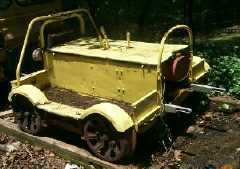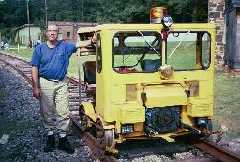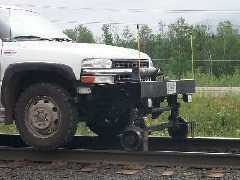Bill's Antique Railroad Motorcars
|
History
|
|
Most people have seen the old black and white movies showing one or more men riding down the rails on a little railcar madly pumping up and down on a handle. Usually, they were trying to outrun a fast moving train. Prior to the invention of internal combustion gasoline engine these hand or pump cars were the only way railroad workers could move along the rails to inspect tracks or make minor repairs. While the situation in the movies was contrived, the real situation did in fact happen in real life from time to time. At the last minute the railroad workers would jump off the moving handcar suffering injuries or worse. |
||
| With the development of the internal combustion engine the first railroad motorcars soon hit the rails. The early gasoline powered motorcars had a 1-cylinder 2-stroke engine. Powered by a mixture of gasoline and oil these 'pop' cars would putt-putt-putt down the rails leaving an oily blue cloud in their wake. Some of the pop cars like the one shown here had no roof or windshield exposing the workers to the elements. Later versions came equipped with a roof, a windshield, and even cushioned seats. |
 |
|
 |
The 4-stroke engine provided much more power and simpler operation. No longer did oil need to be mixed with the gasoline. The larger engines meant the motorcars could be built bigger to haul more men and material. From 2-cylinder inspection cars to 4-cylinder gang cars to 6-cylinder section cars the size, power, and speed of motorcars increased. The larger motorcars could now haul trailers loaded with track repair supplies. Depending on the motorcar as many as 10 or more trailers could be towed along. The motorcar itself provided seating for as many as 14 men. Use of these motorcars and trailers allowed track crews to get to remote locations quickly to make minor repairs. More involved repairs still required a dedicated train to haul larger equipment, tools, supplies, and men. By the late 1970's however, a new technology arrived that eventually led to the end of railroad motorcars as an everyday tool of the railroads. | |
 |
||
| Small, retractable flanged wheels were added to pickup trucks to allow them to drive down the highway at high speed, pull onto a grade crossing, drop the railroad wheels, then travel down the tracks. This had tremendous advantages over traditional railroad motorcars. Besides being able to travel faster to a work site, the workers could ride along in comfort having heat and air-conditioning while being protected from rain and snow. Later on, railroad wheels were added to larger trucks and even small cranes. The era of railroad motorcars was drawing to a close. |
 |
|
|
No longer needing two sets of equipment, railroads began scrapping motorcars as the new trucks began arriving. Luckily, many railroads were willing to sell these surplus railroad motorcars to private individuals. Most motorcars were in terrible shape having been used and abused for many years on the railroad. Often, it was simpler for the railroad to replace or scrap the motorcar than to spend the time and money to fix it. With lots of work and money these cars have been restored and made operational once again. |
||